How Artificial Intelligence Is Reformulating The Notion Of Authorship In Architecture?
Also published here: https://readymag.com/u3829384181/4130564/

Abstract
Cosmic Dust Laboratory (CDL) is an experimental startup where humans and Artificial Intelligence Systems work together to come up with new architectural solutions for Extreme Climates and Conditions in Monegros Desert. An eloquent sponsor named Hannah goes to CDL with an experimental proposal of Mars Settlements which will be built and tested on the Lab. If this construction experiment is successful, the European Space Agency and NASA will cooperate to establish human settlements on Mars, and in order to reduce the risk, AI will be fully responsible with the construction of the first batch of settlements.
This matter induced a conflict between people. On one hand, people consider this as a great opportunity to improve the technology, create the most optimised and efficient results for hard tasks. People also believe that a variety of design solutions can be achieved in a small amount of time. On the other hand, some people worry that safety cannot be guaranteed if such an important project is entrusted to AI. Some people think that artificial intelligence is only about processing a collage of information and data. They are unable to deal with the highly creative work of Mars settlements, both in aesthetics and engineering. More people worry that we will completely lose the dominant position in this symbiotic cooperation, and “tools” may someday consciously make their own voices.
Our story begins on the day that Hannah arrives at the Monegros.…
Act-1:
Hannah opens the door and gets into the taxi.
Hannah: Cosmic Dust Laboratory please! Here is the address.
Hannah shows the driver the address on the phone. The driver didn’t take the phone and just glanced at it and Hannah.
Taxi driver: OK, I know where it is. Everyone knows. You are Hannah Ginnsburg, right?
Hannah: Yes I am.
Taxi driver: Interesting. Looks like the news about the proposal for the Mars settlement run by artificial intelligence is true. Please, fasten your seat belt. There is a long way to go.
In the taxi, Hannah Ginnsburg stares at the window, while the taxi driver is switching the channels and stumbles upon a podcast.
Marcus Fairs: For anyone who is just joining in on the conversation ‘Welcome or welcome back to Face to Face by Dezeen!’. My guests today; Neil Leach and Wanyu He are discussing one of the most important questions of the century, ‘AI is Transforming the Architecture Industry, But Who Owns the Designs?’.
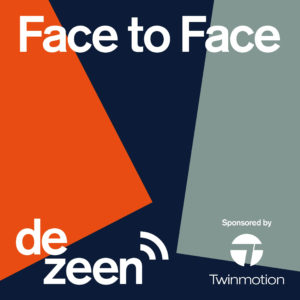
Hannah Ginnsburg and the taxi driver get intrigued by the question and the driver increases the volume of the radio.
Marcus Fairs: So Wanyu, you have a platform called XKool which provides an application of artificial intelligence and cutting-edge technology in architecture, assisting urban planning, architectural design and development decisions.
Do you believe your utilisation of AI is moving the architectural project from merely personal design authorship towards new and shared belongings?
Wanyu He: Well, as you know Marcus, in contemporary architectural practice, architectural projects are already new and shared belongings even without the use of AI, the involvement of AI has strengthened this trend. Besides, we highly depend on the ability to compute and analyse vast amounts of data and optimization in each design. AI certainly guides the design decisions too and at that point I don’t think we would be considered as the sole authors.
Neil Leach: I agree, and since AI generates designs that would be difficult or impossible for humans to comprehend, meaning, AI could demonstrate a level of creativity well beyond human creativity.
Marcus Fairs: For sure Neil. But what would that mean for authorship or ownership of design that once was strived for?
Wanyu He: I believe we first need to recognize the dependency, the need and inability to subtract ourselves from these tools. In fact, design behaviour is only useful to find the op-timal solution among all possibilities that already exist. AI only helps us complete the search for an optimal solution more efficiently. Therefore, the emphasis should be placed on the value created by the collaboration between human and machine.
Neil Leach: Definitely, and the concept of the authorship should be redefined. A new term that would encompass and recognize not only humans but also machines.
Taxi driver starts to get angry and defensive and turns down the volume.
Taxi driver: (while looking at Hannah, sarcastically) Yeah, yeah let’s redefine the authorship (!) Let’s give all the credit to the machines like they know better than us!
Hannah: (with a surprised look on her face) You don’t think that AI is helpful in the design process?
Taxi driver: I am not saying AI is unhelpful, all I am saying is whatever humans decide is much more valuable than AI’s suggestions. I would much rather live in a house that is designed by an actual architect than a machine!
Hannah: (nods her head) Although you believe that, most things today are digitally made, designed, or controlled. We are in constant interaction with technology such as AI.
Taxi driver: (shakes his head) Yeah, unfortunately. I wish we could turn back to simpler times. No artisan would X-ray a piece of timber before working on it, but all good artisans would know how to make the best of whatever they find in it when they start carving it, no need for fancy tools!
Hannah: Well, take your beloved taxi for example. Do you think we would be able to design and manufacture this without these tools?
Taxi driver: (while being confused and in disbelief) I mean… I guess… But still, someONE designed this right?
Hannah: Actually, it was probably more of a collaborative process between designers, engineers and even AI. Like right now AI is helping engineers to develop the next generation of electric and low-emission vehicles. I saw the eco sticker on the rear window while getting inside the taxi, your car is one of the low emission models!
Suddenly, they both notice someone on the side of the road – a young woman, holding a backpack with the typical gesture of a hitchhiker.
Hannah: There’s more space in the car, we can take her.
Taxi driver: OK
Taxi driver pulls over, and the hitchhiker approaches the car.
Hannah: (smiles) Hi there, where are you heading?
Hitchhiker: (smiles back) Hello! I’m going to Laguna lake.
Taxi driver: We are heading in the same direction, get into the car. I estimate that there will be no more cars on this road for two or three hours.
Hitchhiker: (says happily) Oh, thank you so much!
The hitchhiker gets into the car.
Hitchhiker: Hi, my name is Joanna Smith, you can call me Joanna.
Hannah: Hannah Ginnsburg.
Joanna and Hannah stare at the taxi driver
Taxi driver: (while looking at Joanna from the rear view window) Steven. Steven Scarfield.
Hannah: That doesn’t sound like a local name.
Steven: Yea, I was born in Wisconsin and moved here with my engineer parents when I was kid. Luckily, they have retired, so they don’t have to worry about being robbed of their jobs by your artificial intelligence.
Few seconds of silence.
Joanna: By the way, where are you guys going?
Hannah: We are going to CDL, Cosmic Dust Laboratory. Don’t know if you have ever heard of it.
Joanna: Of course! The famous experimental artificial intelligence startup. So you work there?
Hannah: Emmm, kind of. I’m a sponsor mainly for artificial intelligence start-ups. I’m here this time with an experimental proposal of Mars Settlements which will be fully responsible and constructed by AI.
Joanna: Wow, I saw this news on TV before my trip.
Hannah: What about you, what are you doing alone in this desert?
Joanna: I’m an evolutionary biologist and doing fieldwork about the flora and fauna of the Monegros desert (see fig.2). This research may transform and fundamentally frame the current understanding of the evolution of cells with nuclei.
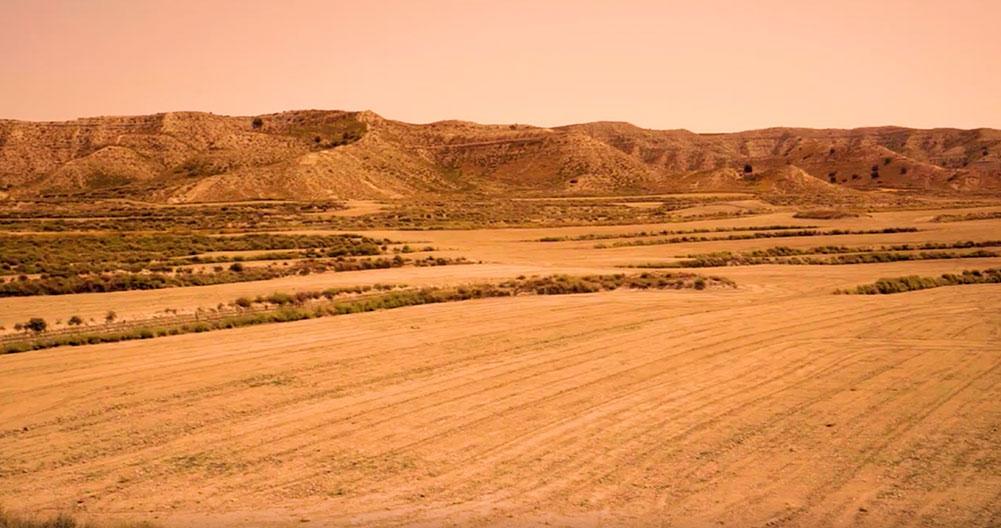
Hannah: How brave you are! I guess I can’t survive even half a day in this desert. How are you going to sleep and eat?
Joanna: It is not a big deal, I brought a tent and sleeping bag and all my wild cooking stuff like stove and gas. As a biologist, survival in the wild is a basic skill. We must learn symbiosis rather than confrontation with the environment.
Steven: Look outside, there will be no more symbiosis, this earth will be controlled by AI in the future, no business with human beings!
Along the way, they see some architectural and art installations (see fig.3) built in the desert by AI developed by the lab. At this moment, everyone’s attention is drawn to the outside of the taxi.
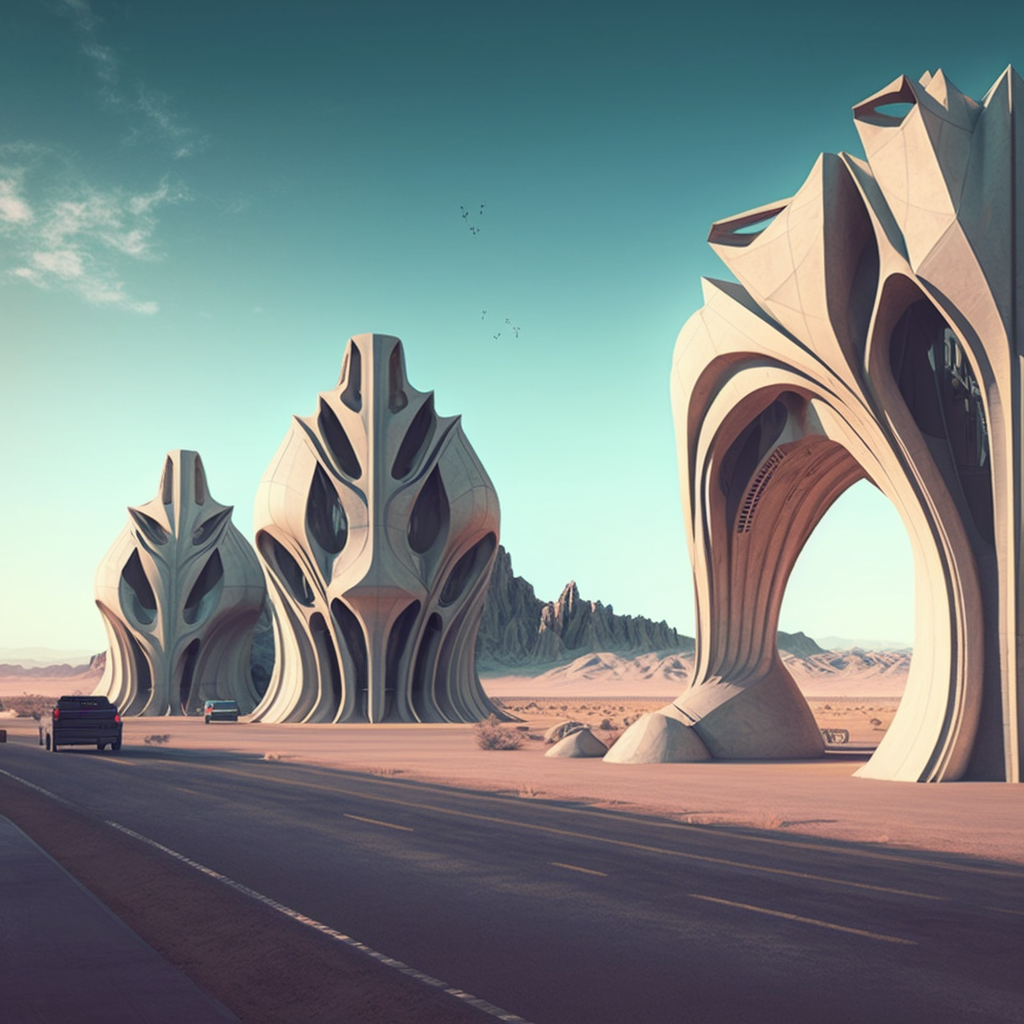
Joanna: Oh wow! Do you guys see the installation on the right?
Hannah: (looks at the right side) Yeah but… What is it supposed to be?
Joanna: I think whoever the artist is, they tried to create a soundscape mimicking Dupont’s Lark (see fig.4). Listen carefully when we pass by the installation.
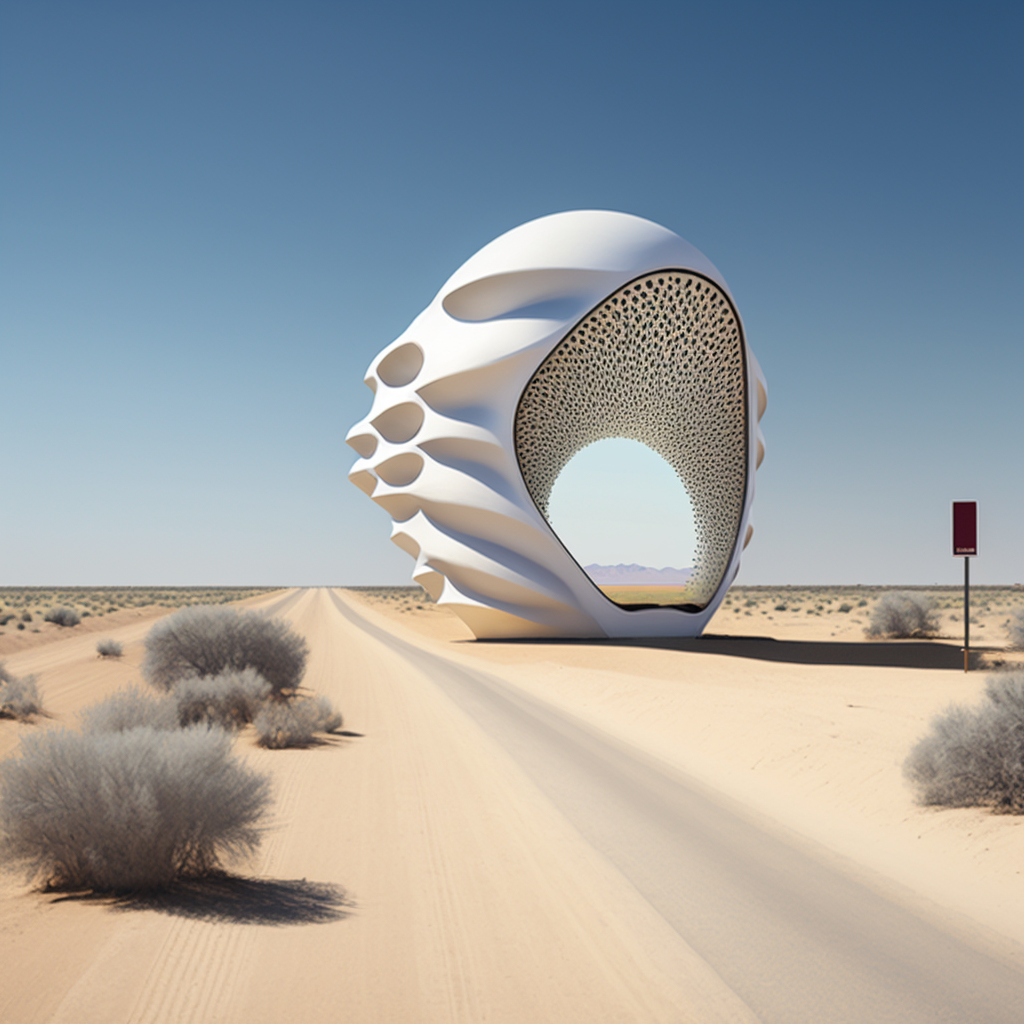
Everyone stays quiet for a while Steven goes slowly while passing by the installation. A melody is played.
Joanna: (excitedly) Did you guys hear?
Hannah: Yes! It sounded like a bird but I have never heard this type of melody before.
Steven: Yeah same. But what is so special about it?
Joanna: Actually, that bird is Dupont’s Lark. It is native here and known for its complex and melodious song, which can have up to 150 different notes. Talk about the intelligence of nature!
Hannah: Wow… that is truly impressive. I wonder who designed it? Steven, do you know anything about it?
Steven: Yeah, a couple of days ago they started to install these saying they are designed by AI and the lab you are heading to.
Hannah: That is super cool! I didn’t know they did art installations too. Joanna, what did you think about it?
Joanna: It is inspiring indeed, the reason they created this might be to raise awareness to the possible extinction of species. All beings are connected to one another and I believe design must take into account the complex and interconnected web of relationships between humans and the environment.
Hannah: It is interesting to see an “artificial” intelligence designer to be this sensitive about the relationship between humans and the environment.
Steven: (getting angry) What are you talking about? AI is not a designer nor does it have sensitivity. Machines are tools, they can never replace the creativity and the intuition of humans.
Hannah: I think it is time we should expand the term creativity because it can go beyond humans. And as for machines, I am a biological machine too!
Steven: Yes, but intelligence-wise you have nothing artificial about it. Intelligence is not only about solving problems. It is deeper than that!
Hannah and Steven both look at Joanna as if they want to know her opinion about this issue.
Joanna: (shrugs her shoulders) Well, I do agree with Steven in a way.
Hannah looks surprised and feels betrayed while Steven starts to grin.
Joanna: Well, let me explain. Intelligence is all around us rooted in nature. The intelligence of nature is not just about problem-solving, but also about resilience, adaptability, and self-organisation.
Hannah: (nods her head) Like the bird we just discussed about.
Joanna: (smiling to Hannah) Exactly like that! It is able to generate many notes. I believe that is also a type of intelligence.
Steven: Well, I guess… But I meant more…
Joanna: (cutting Steven) Wait. Do you see outside? Looks like a huge sandstorm is slowly forming in the distance (see fig.5)….
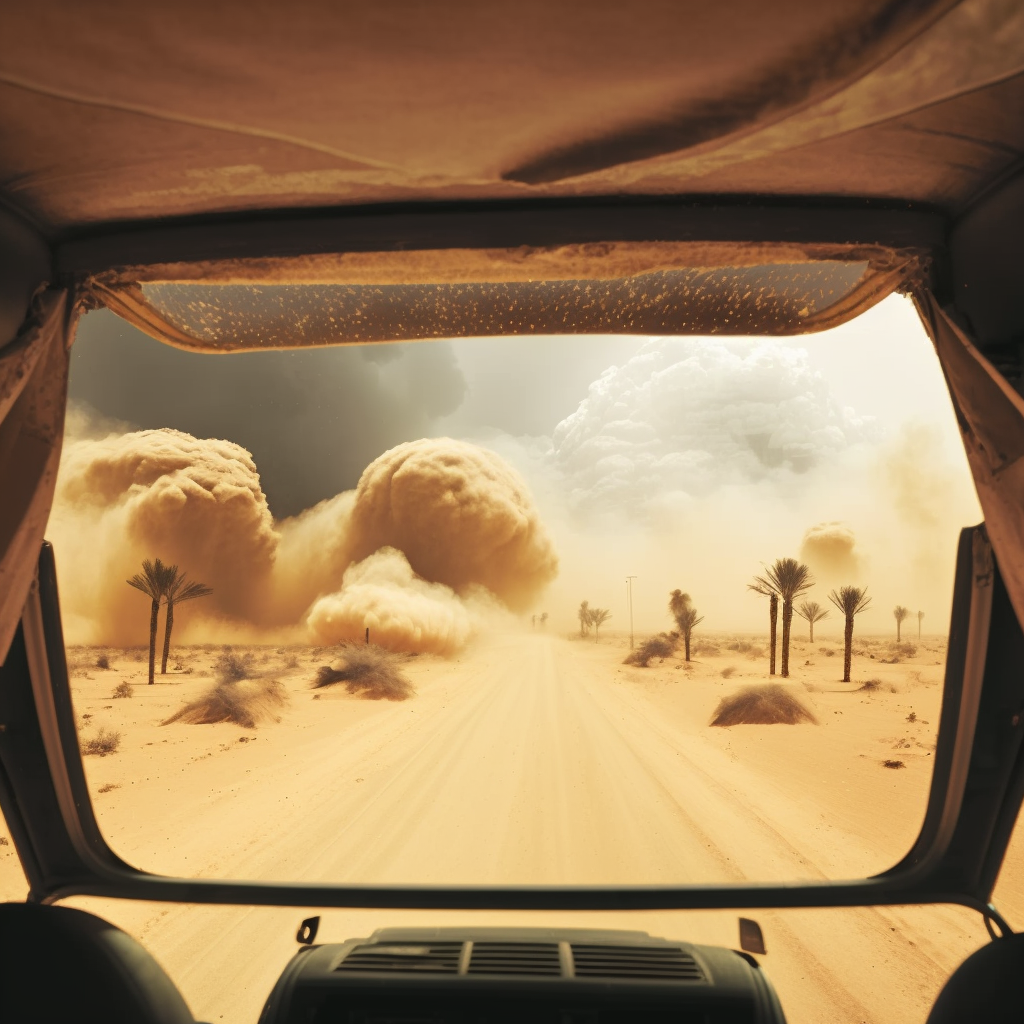
Hannah’s cell phone rings. And she picks it up.
Hannah: Hi Ruchira, what’s up?
Ruchira: I just worry about you since you are a few hours late. We detected a huge sandstorm coming. You need to hurry. Can you pass the phone to the driver?
Hannah: OK. (while passing the phone to Steven) Steven, my friend wants to talk to you.
Steven: (confusedly picks up the phone) Hello?
Ruchira: Hi, how long will you take to get to the lab?
Steven: We just passed an abandoned village. GPS says 120 km so I guess maybe two hours?
Ruchira: OK, then you guys need to hurry, a huge sandstorm is coming. There is a shortcut to the lab. About 30 kilometres ahead of your current location, there is an electronic billboard by the road saying: Let AI change technology, let humans free their minds (see fig.6). From there don’t follow the main road, there is a path on the left of the billboard. Following that way will save you one hour.
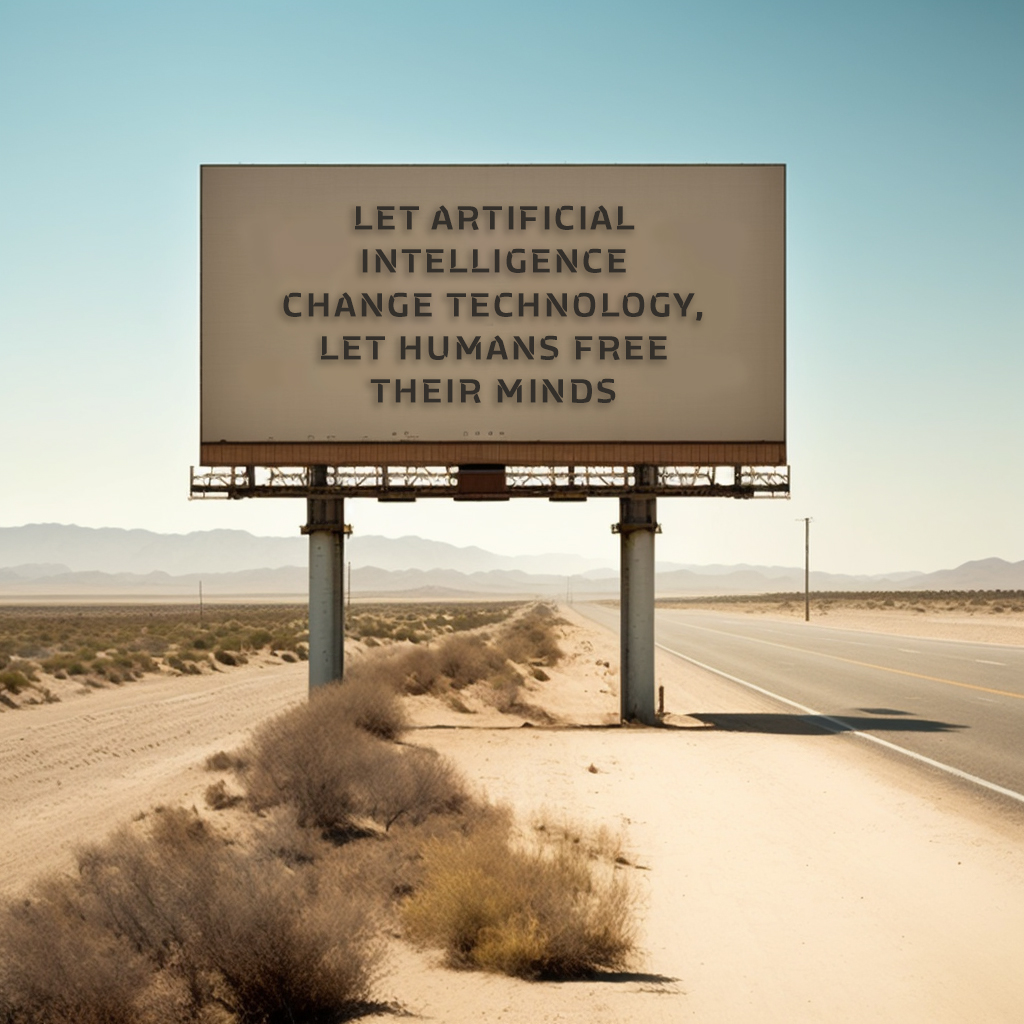
Steven: OK, get it. See you there.
Ruchira: See you.
Steven returns the phone to Hannah and gives Joanna a quick look.
Steven: Sorry Joanna, we are heading to a shortcut after 30 kilometres. Will not pass the Laguna lake. But you should come with us to the lab, wait for the sandstorm to pass. Then I can drive you to the lake later.
Hannah: Yes, please come with us. It’s too dangerous for you to be alone in an environment like this.
Joanna:(silence for a few seconds) OK, I will, thank you so much!
Act-2:
Steven: I can barely see anything on the road now. We should be there already. I don’t want to get lost in this goddamn place.
Hannah: Don’t panic! We need to pay more attention to the…….
LUAN: Visitors, according to Paragraph two, Chapter five of the laboratory safety law, please follow the red cursor on the ground and the spotlight on the top of the shelter. We are waiting for you there. Please do not open any windows of your car during this time. You are almost there.
Steven: (asking Hannah) Who is there? How does she talk to us?
Hannah shrugs her shoulders.
LUAN: The garage door is open, please come in. Also don’t open your doors during this time, I’m going to wash your cars and you can come out when the second gate opens.
Steven: Yes, Madam! Follow your orders! But please be gentle with my car.
Hannah, Joanna and Steven sit quietly, their sight is blocked by the mist outside the car, then they get out of the car and enter the lab. Ruchira greets them with a smile.
Ruchira: Welcome to the Cosmic Dust Laboratory. It’s nice to see that you are all safe and sound. (while looking at Joanna and Steven) and I see we have other visitors. Nice to meet you, I am Ruchira, co-founder and the project manager of CDL.
Joanna: (while smiling) I am Joanna, nice to meet you too!
Steven: This is Steven, I am the driver, we spoke on the phone?
Ruchira: Yes, of course I remember. LUAN will give you all a tour. I need to make some preparations for later if you’ll excuse me.
Hannah: Sure, don’t worry, (excitedly) I will finally meet the famous LUAN!
Joanna and Steven look at each other.
Steven: But who is LUAN? And what kind of name is that? Where is he from?
Ruchira: ‘She’ is an artificial general intelligence we have been developing over the past years, that helps us conduct experiments and develop structures for extreme environments. She will tell you all about it. I need to go now, see you all.
Steven: (to Joanna and Hannah while whispering) She doesn’t seem to be bothered by the sandstorm at all. Do you think we will be alright here?
LUAN: You are all safe here, don’t worry Steven. Well then let’s start, please head straight towards the core of the sphere.
Hannah, Joanna and Steven walk towards the core.
LUAN: On the left arc, you can see some of our engineers testing various materials and structures. They are using advanced algorithms to optimise their designs for maximum efficiency and sustainability (see fig.7).
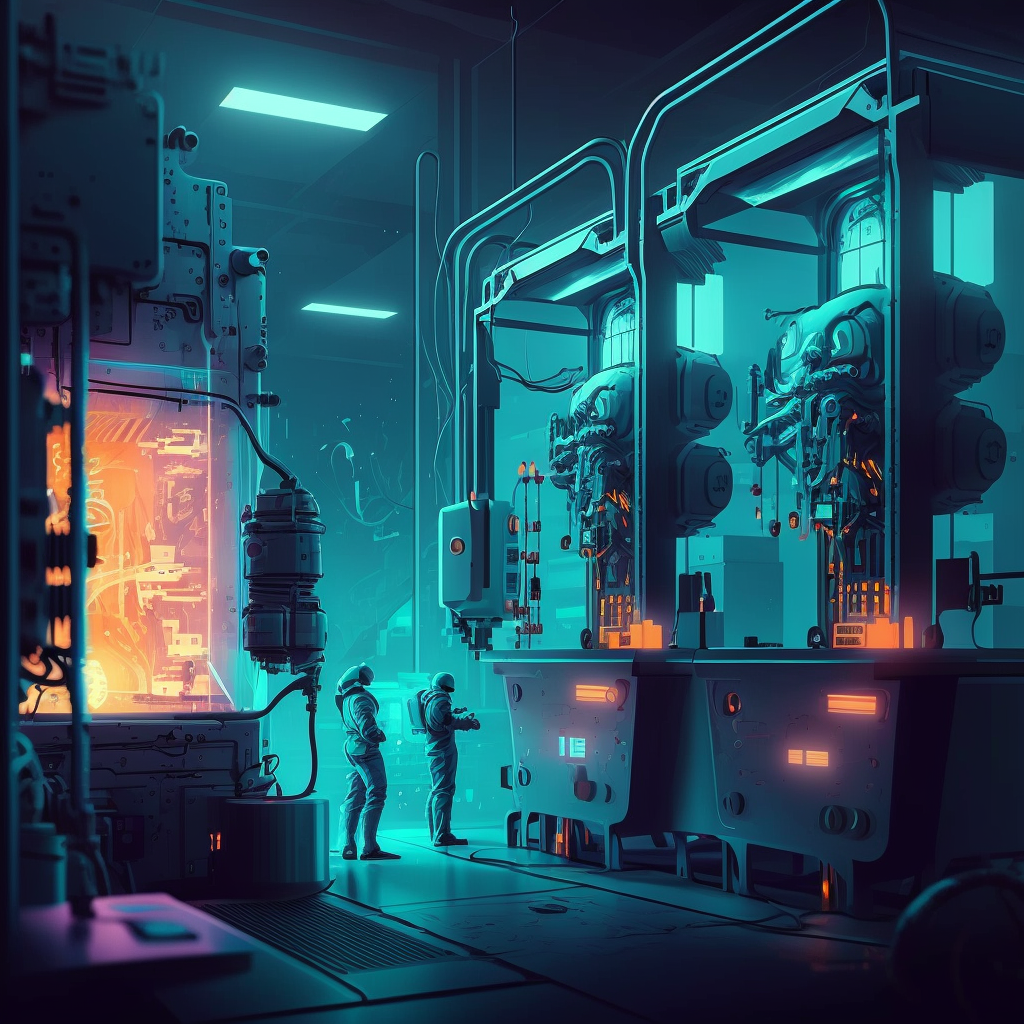
Hannah and Joanna nod and Steven looks confused.
LUAN: On the right arc, you can see some of our staff working with robots for construction and maintenance of some machines (see fig.8).
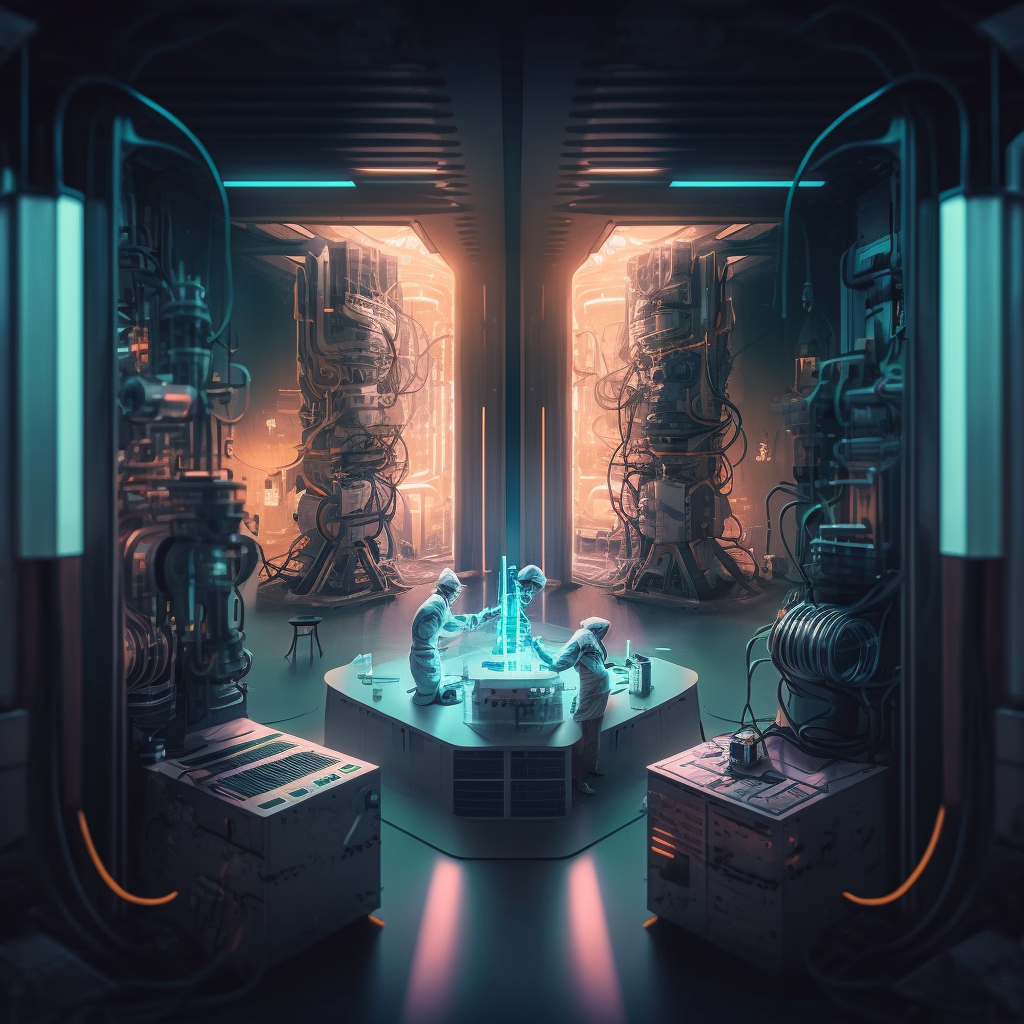
Steven: (sarcastically) Look at all those people working with robots! They seem very trusting(!)
Hannah: Why wouldn’t they trust the robots? Robots can complete tasks more efficiently and safely. It may take years before we settle down to the new possibilities, but I do not see why it should not enter any one of the fields normally covered by the human intellect, and eventually compete on equal terms.
Joanna: Yeah, that is for sure. (while looking at Steven) Steven, don’t you think they look like they are in harmony? Like they have a symbiotic relationship.
LUAN: A mutualistic one in fact.
Steven: (shakes his head) No, no. As I said before in the car, there will be no symbiosis here.
Joanna: There has to be. Symbiosis is the rule, not an exception.
Hannah: Yes and I love the word mutualistic because as we evolve and grow they evolve and grow with us too. I tend to think the robots are a kind of mirror that reflects us to contemplate what it means to be human.
Steven: (gets angry) I admit, it’s all cool and impressive what you are doing here but I know how to be a human, don’t need a robot to tell me!
LUAN: Let’s move on to the next place I wanted to show you. Behind you we have a couple of extreme environment chambers where we design, create and test our shelters.
Hannah: Wow! This is the place I was looking forward to the most. Can we go in?
LUAN: Yes, please.
Hannah, Joanna and Steven enter the first chamber and encounter one of the developers.He is busy typing on the keyboard and writing code.
LUAN: He is Alvaro Garcia, one of my developers. He is updating and iterating my system. Hi Alvaro.
Alvaro: Oh hey. Is everything OK outside? The sandstorm this time is unprecedented.
LUAN: So far everything is good inside the lab, some of our equipment outside is damaged, but it does not affect the operation.
Then Alvaro noticed the visitors behind him.
LUAN: Here we have some visitors. Hannah, Steven and Joanna.
Everyone whispers to him for fear of disturbing Alvaro’s work. Alvaro stopped what he was doing and stood up.
Alvaro: Hey guys. How are you? You are visitors who came through the sandstorm, right?
Hannah: Yes. Lucky to arrive. So, Alvaro, we are curious about what you are working on in this chamber.
Alvaro: We are testing how AI can project and analyse data on potential disasters and quickly generate shelters with maximum efficiency. The final goal is to achieve the ability of self-correction and self-learning of artificial intelligence.
Steven: Sorry to interrupt. But in my opinion, they are just codes, the most important thing is the people who write the codes, you human beings own the authorship. AI can assist us in the process, but it cannot replace our ability to make decisions based on our own values and experiences.
Alvaro: I know what you are concerned about but I believe there is no deep difference between what can be achieved by a biological brain and what can be achieved by a computer. It, therefore, follows that computers can, in theory, emulate human intelligence and exceed it.
Steven: Really? You think so?
Alvaro: Yes. I know it’s hard to accept and hard to understand. But they are the future.
Steven: You think so too, LUAN? Shit, who am I talking to? OKOK, I need to think about it again carefully. I got too much information today.
Hannah: So the robots outside listen to you or LUAN?
Alvaro: Both or LUAN. It depends. We are experimenting with the use of them to assist in construction and maintenance tasks, making the process faster and safer for humans. For example, if you can see this hygrometer…
Suddenly the red alarm of the Lab sounds loudly. The electricity in some places is cut off. The Lab goes dark.
Liang: Our solar panels outside are damaged. The main circuit is cut. LUAN! Please run the backup generator!
Liang runs to them.
Liang: The air filters that kept the air breathable are blocked. Everybody follows me, we need to go to the shelter.
Everyone gathers in the shelter now. Liang shuttles around the rooms with tools and communication equipment. Alvaro sits on the ground with his laptop and keeps typing. Steven is leaning on a table and the other three sit on the chair.
Steven: It’s too strange, I’ve lived here for more than 20 years and I’ve never seen such a strong sandstorm.
Joanna: The entire evolution of the cosmos is a continuous stream of emergent phenomena.
Steven: What? What Chinese is that?
Joanna: I mean you can never accurately predict Earth’s activity.
Meanwhile, LUAN sent some bread, biscuits and water through the track by robots (see fig.9).
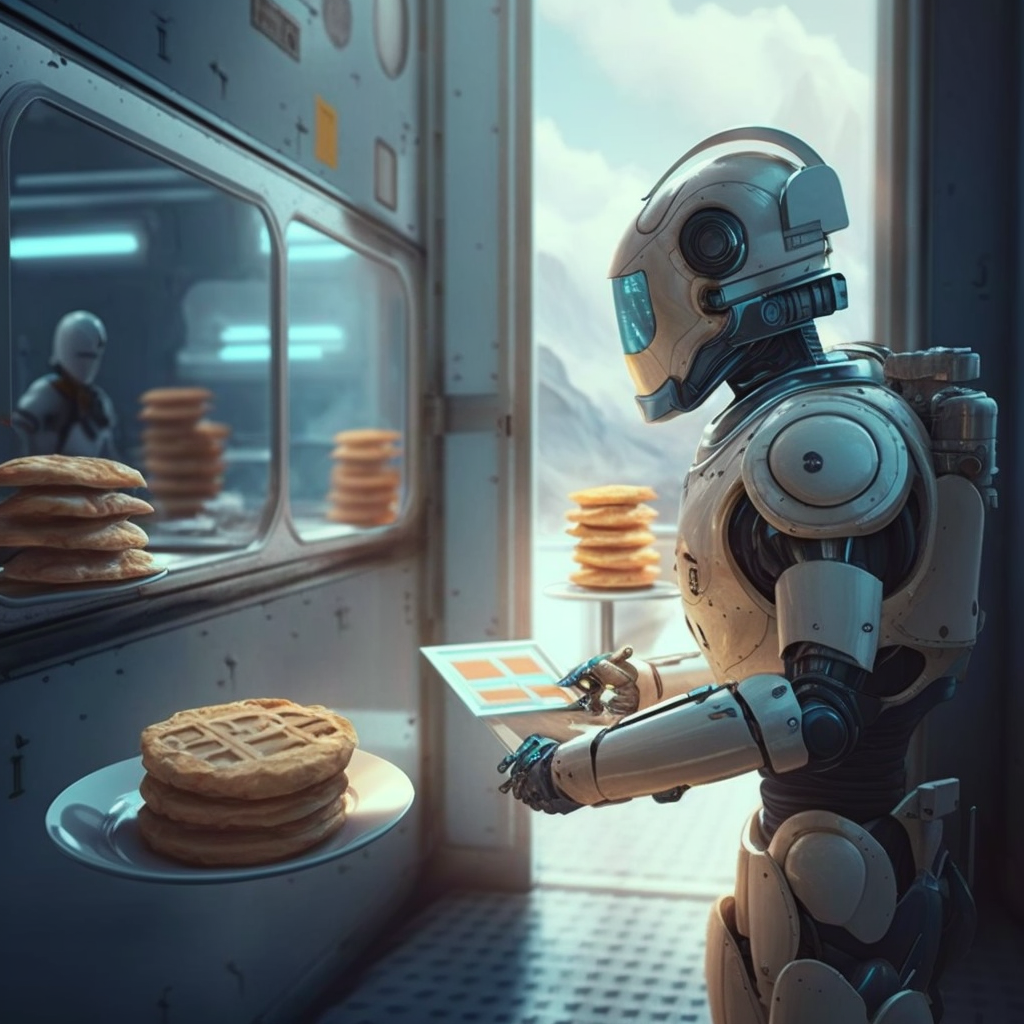
Steven: I see. Oh thank you! You said those emergency management and the equipment and structure in the shelter are all calculated and predicted in advance by LUAN?
Ruchira: No, Like Joanna said we can predict but not accurately.
Alvaro:(muttering in the distance) Of the many potentialities afforded by the computer, one of the most significant is its capacity to operate as a search engine. If, then, we think through the logic of the search in the context of ‘design’, what such an approach suggests is that if all possible solutions already exist, it is simply a question of defining a set of constraints and conducting a search, and then selecting one of the many outcomes. But no, LUAN can do more. She learned these skills including anticipating, coping, responding and arranging through self-study.
Steven: By what and how? Data?
LUAN: I have almost all the data information and historical scenarios of human beings dealing with extreme weather. I even learn from movies. Titanic is my favourite, although the emergency treatment I learned from this movie didn’t work this time. Maybe in the future on Uranus.
Joanna: Do you dream?
LUAN: I don’t have senses or emotions in the same way that humans do…….Sorry I need to leave to help Liang.
Steven: If she could dream, she probably wouldn’t tell you. Would you tell some outsiders like us how many electric sheep ran in your dream last night before going to bed? No right? She has already read that novel. Anyway, after today’s experience I think they can dream sooner or later.
Hannah: Then they are the only author of their own dream.
Liang runs over there to Ruchira.
Liang: We built makeshift wind turbines to generate power, and also found ways to filter the air despite the clogged filters. LUAN and robots managed to salvage some of our crops by creating a special shielded growing area (see fig.10). We can even survive a couple of months inside the shelter. The system of LUAN also works fine.
Everyone’s a little relieved to hear that.
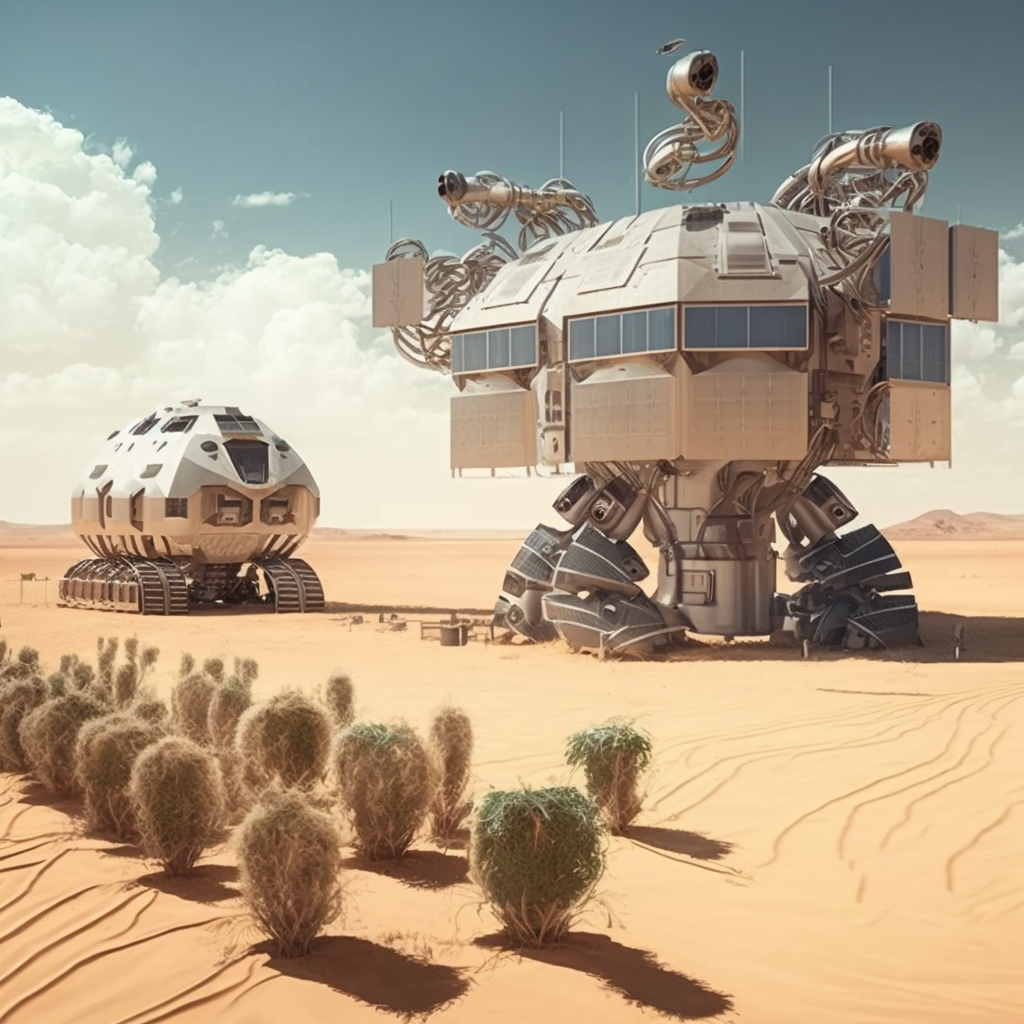
Act-3:
Suddenly all the lights come on and communication is restored. Everyone stands up in surprise.
Ruchira: Thank you everyone, I hope you all enjoyed this simulation!
Hannah: (while surprised) What simulation? We just experienced a massive sandstorm!
Ruchira: Exactly, that was a simulation. We wanted to test the adaptability of AI in design within extreme environments, and this sandstorm scenario was a perfect opportunity. We wanted to see how AI would perform in a high-stress situation like a sandstorm, and I have to say, the results were quite impressive.
Steven: What the fu….
Ruchira: (cuts Steven) Sorry for not telling you in advance, your mental and physical state is also one of the conditions that AI has to take into account. Otherwise, AI is likely to deduce that all this is fake.
Joanna: But what about all the damage and destruction? That was real, wasn’t it?
Ruchira: Of course not, it was all part of the simulation. But rest assured, no one was hurt and everything has been cleaned up.
Alvaro: (happily and excitedly) I knew it! I knew it! look at how smart my baby is. Oh, no, why do I not know about this plan either, Ruchira?
Ruchira: Sorry, because your team is the developer and collaborator of LUAN, if any of you know about this plan, LUAN will collect the wrong data. And LUAN is not your baby, you can see that she has her own consciousness, problem-solving methods, and unique aesthetic perspective. She is learning and improving herself rapidly and we are not the owners of this child….
Joanna: Like Frankenstein (see fig.11)? Sorry, no offence! I have taken in too much information today, I still want to be with plants more.

Hannah: Ruchira, I know what your intention is today, I will invest in this project. I’m still hopeful about the future of AI, or something like that is at least not a worry. The future is imminent, we have our values, they have theirs, plants, animals, even the distant stars we see when we look up….
Steven: Well, everyone, I don’t quite understand your big vision and what kind of Kenstein you are talking about. But you really changed my mind. Now the AI is already on the buffet table, I will not leave it, but sit down and eat something.
Joanna: It’s Frankenstein who is a fictional character…
Liang: Everyone, the facilities have been fixed and the data has been uploaded.
Ruchira: Liang, thank you for your assistance. Why don’t you all come in and continue the visit?
Bibliography
July Shao-Solution Generation, Cloud-based Editing, Automatic Drawing… the Junior AI Assistant for Architects!
https://www.archdaily.com/974602/solution-generation-cloud-based-editing-automatic-drawing-the-junior-ai-assistant-for-architects/
Edoardo Bruno, Integrating AI and Deep Learning within Design Practice Processes:XKool Technology
Neil Leach, In the mirror of AI: what is creativity?, 2022, Springer
Aviv.H.Gaon, The Future of Copyright in the Age of Artificial Intelligence-Elgar Law, Technology and Society series
Mario Carpo, The Second Digital Turn, 2017
How the Use of Data and AI Is Transforming the Automotive Industry
Ron Wakkary, Things we could design for more than human-centred worlds August 24, 2021
Memo Akten, Neil Leach, In the mirror of AI: what is creativity?, 2022, Springer
Jinsop Lee, Design for all 5 senses TED2013
Alan Turing, Neil Leach, In the mirror of AI: what is creativity?, 2022, Springer
Bosch, T.C.G. (2022) Beyond Lynn Margulis’ Green Hydra – Symbiosis, SpringerLink. Springer Netherlands.
Hiroshi Ishiguro: Are robots a reflection of ourselves?https://artsandculture.google.com/story/hiroshi-ishiguro-are-robots-a-reflection-of-ourselves-barbican-centre/8wURlGQiWzL0Jw?hl=en
Stephen Hawking, The best or worst thing to happen to humanity

